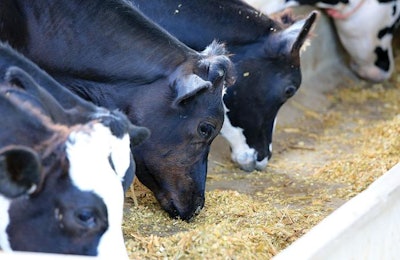
The abolition of the European Union’s milk quota system started a period of insecurity for dairy farmers. First introduced in 1984 at a time when EU production far outstripped demand, the quota regime was one of the tools introduced for overcoming surpluses. Successive reforms of the EU's Common Agriculture Policy have increased the market orientation of the sector and, in parallel, provided a range of other, more targeted instruments to help support producers.
No one really knew what the side effects of the abolition of the EU milk quota system would be, but 20 months in and the dairy industry has been at rock bottom. An oversupply in the EU and in the rest of the world, coupled by some big international customers closing their order books, meant dairy prices hit the floor.
But it wasn’t only dairy farmers that felt the pain of low milk prices. The crash had a knock-on effect on ancillary industries, such as the feed industry.
Feed compounders, which total 4,000 in the EU, noticed the demand for livestock concentrates fall when the milk quota system ended.
Demand for feed in the EU went hand in hand with the price of milk and as it fell, so too did the tonnage of material purchased.
Feed demand fell in 2014-15 and is expected to fall again in 2016, but hopes are that the industry picks up again in 2017.
Optimistic for demand hike
Alexander Döring, secretary general of the European Feed Manufacturers’ Federation (FEFAC), is optimistic for a hike in feed demand next year.
“Overall, industrial compound cattle feed production fell by 0.7 percent in the year 2014 to 2015, with a further decline expected in 2016,” Döring explains. “While milk deliveries increased post quota, many dairy farmers reduced uptake of feed concentrates due to depressed milk prices.”
In Döring’s opinion, the demand for dairy feed concentrates depends on weather’s impact on forage availability and milk prices. If price recovery continues, 2017 demand for feed concentrates may increase.
His views are shared by FEFAC president Ruud Tijssens, who has called for more stability in international feed supplies.
“It has been an extraordinarily challenging year for our customers,” Tijssens notes. “It is no secret that the economic squeeze is also felt by the feed industry, being the main supplier.”
Common market disruption
FEFAC has called on the European Commission to remove non-tariff trade barriers that jeopardize access to competitively priced feed supplies.
“It should be a political priority to alleviate pressure on the already troubled livestock farmers,” Tijssens says.
Despite the European Parliament rejection, the Commission has kept the "opt-out" proposal for EU-approved GMO food and feed events on the table, meaning disruption of the common market is still a potential outcome.
Tijssens warns it could lead to a 10 percent increase in feed costs for EU livestock farmers in opt-out countries where GMO soy would need to be replaced with non-GMO soy.
“It is of crucial importance that the EU feed and livestock sector remains competitive and continues to have access to global feed supplies to maintain market predictability as the basis for our livestock farmers so they can capture their fair share in very dynamic global markets for animal products,” he says.
Aftershocks felt
The aftershocks of the quota ending have been felt all across the EU’s 28 member states as numbers of dairy farms decrease.
And, European Milk Board general director Silvia Däberitz says overproduction is adding to the problems in an already saturated market.
“EU milk policy took a turn in 2003 when deregulation of the milk market started,” Däberitz says. “This policy peaked in 2015 with the abolition of production quotas, which were introduced in 1984 as a response to massive overproduction.”
As a preparation for the end of quotas in 2015, the production limits were already raised by 9.8 percent between 2004-05 and 2014-15, with visible effects on farm-gate prices, she explains, noting that supply had not been in balance with demand.
“Overproduction occurred with the result that, in 2009, farm-gate prices plummeted to around 25 cents/kilo of milk causing a loss of revenue of around 11 billion euros for European dairy farmers,” recalls Däberitz.
Out of business
The milk price crisis has forced many farmers out of business and heavily burdened the finances of remaining producers.
“Since the end of the milk quota system, the dairy market has faced an even bigger challenge, because the successor system lacks effective instruments for preventing a damaging surplus of production,” Däberitz explains. “Already in 2014, higher prices and expectations of a quota-free market triggered a 4.3 percent production increase in the EU.”
Meanwhile, 10 percent volume increases in New Zealand and 2.4 percent in the United States have created an 11 million ton milk surplus on the world market.
“The market is saturated and the additional volume is putting immense pressure on farm-gate prices,” Däberitz says. “That is also becoming clear in 2015, with an additional production volume of 2.8 percent in the EU between April and July compared to the same period in 2014.”
To exemplify how dramatically prices have dropped, by the end of the summer in 2015, dairy farmers in the Baltic States were being paid less than 20 cents/liter, she notes.
Voluntary supply
In October, the voluntary milk supply reduction scheme, which compensates farmers that produce less milk, has helped reduce production volumes.
However, in Däberitz’s opinion, the dairy sector will remain prone to crisis as long as there is no regular crisis instrument on EU level.
“As long as decision-makers do not agree on such a sustainable instrument, price slumps will happen regularly,” she says.
Dairy product prices have been boosted by more than 11 percent at the recent Global Dairy Trade indicating greater positivity in the market. Industry predictions insist that 2017 will see much needed better returns to dairy farmers once the gap between demand and supply has evened out somewhat.

















